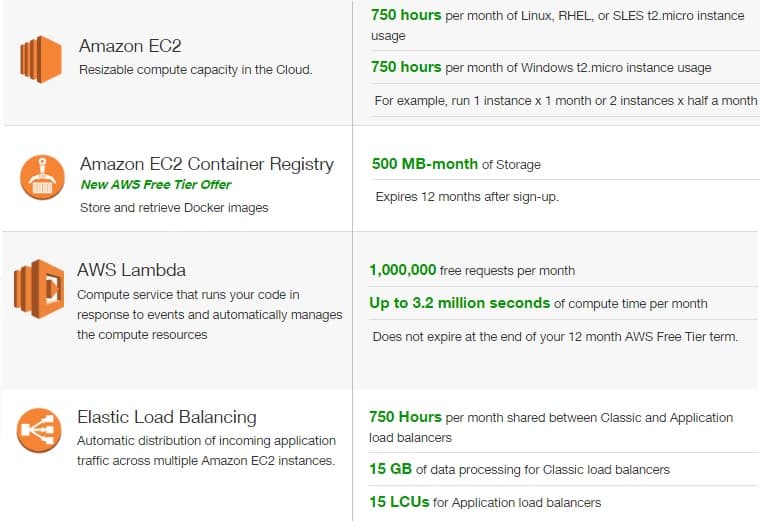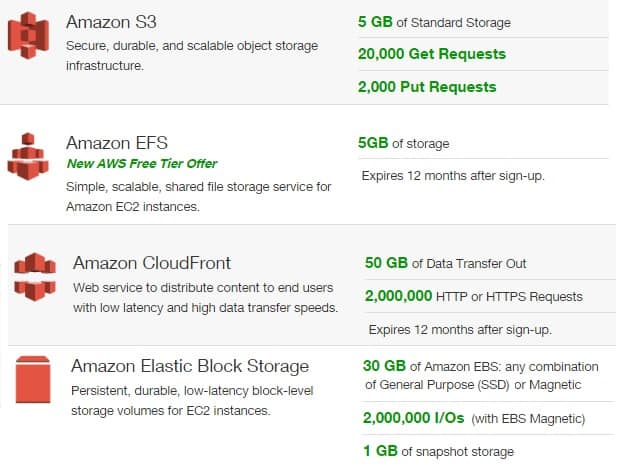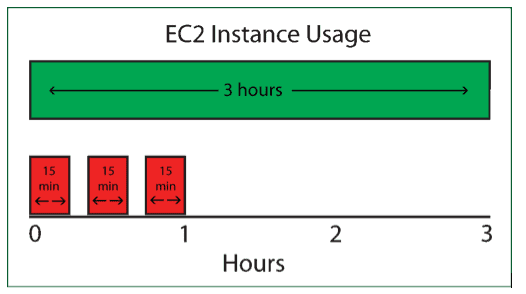Types of offers in AWS
12-Months Free: Only new customers are eligible for 12 months of free service. If you exceed the allowed usage then you will be charged according to pay-as-you-go service rates.
Always Free: These services can be availed by all old and new customers. They don’t expire after 12 months of free usage. There are few limation on the usage but very advantageous when you perform POCs.
Trials: Services are available for short term and limited usage and the Azure free trial starts from the time you start using the service. After the period is over you can still avail of all the services by only paying pay-as-you-go service rates.
Note: The Amazon Free Tier isn’t available within the AWS GovCloud (US) Regions or the China (Beijing) region at this point. The Lambda free tier is out there within the AWS GovCloud (US) Region.
AWS Free Tier limits
All services that are provided with AWS Free Tier have limits and the usage is capped. Many services have multiple sorts of limits. for instance, Amazon EC2 has limits on both the type of instance you’ll use and the limited hours use every month for 12 months. Amazon S3 features a limit on what proportion storage you’ll use and on how often you’ll call certain operations monthly, for instance, Amazon Free Tier covers the primary 20,000 times you retrieve a file from Amazon S3, but you’re charged for extra file retrievals. Each service has limits that are unique to service.
Database limits
AWS Offer 4 DB Services and all can be available in an Azure Free account with few limitations of course.
RDS: It consists of two components, computes and storage. It is easier to line up, operate, and scale databases within the cloud. It provides cost-efficient, resizable capacity in an industry-standard electronic database and manages common database administration tasks.
DynamoDB: In this data storage pricing is pretty straight-forward: you’re charged a price per GB per month. This rate varies across regions but is between $0.25 and $0.30 per GB-month in most regions. The second pricing parameter, provisioned throughput, maybe a little more novel.
Amazon ElastiCache: It provides Caching-as-a-Service from Amazon Web Services. AWS simplifies fixing, managing, and scaling a distributed in-memory cache environment within the cloud.
Amazon Redshift: It is a fully managed petabyte-scale data warehouse service. Redshift delivers fast query and I/O performance for virtually any size dataset by using columnar storage technology and parallelizing and distributing queries across multiple nodes.
Know more: here we have discussed what Elastic Beanstalk is, what is the advantage, and the working of Elastic Beanstalk.

Analytics Limits
Amazon Kinesis Data Analytics is the easiest method to research streaming data, gain actionable insights, and answer your business and customer needs. Amazon Kinesis Data Analytics reduces the complexity of the building, managing, and integrating streaming applications with other AWS services.
AWS Data Pipeline: Amazon Data Pipeline is an “infrastructure-as-a-service” web services that support automating the transport and transformation of knowledge. Pipelines reflect an ETL process that permits you to get more value from your data across multiple sources via data extraction and data transformation downstream to Amazon Web Services.
Amazon Elasticsearch Service (Amazon ES): It is a fully managed service that creates it easy for you to deploy, secure, operate, and scale Elasticsearch within the AWS Cloud so you’ll search, analyze, and visualize your data at scale.

Compute Limits
The Compute category of services is key resources that allow you to carry out computational abilities via a series of instructions used by applications and systems. These resources cover a range of different services and features.
Amazon EC2: Amazon charges based on hours of usage, not based on the number of instances you’re running. It is designed to form web-scale cloud computing easier for developers. Amazon EC2’s simple web service interface allows you to get and configure capacity with minimal friction.
Amazon EC2 Container Registry (ECR): It is a secure, fully-managed Docker container registry that makes it easy for developers to store, manage, and deploy Docker container images. Amazon ECR is integrated with Amazon EC2 Container Service (ECS), simplifying your development to production workflow.
AWS Lambda: Lambda fills the first role of the compute service on AWS. It also integrates with many other AWS services and, alongside API Gateway, DynamoDB and RDS form the idea for Serverless solutions for those using AWS.
Elastic Load Balancing: It distributes incoming application or network traffic across multiple targets. Elastic Load Balancing scales your load balancer as traffic to your application changes over time. It can automatically scale to the overwhelming majority of workloads.

Storage Limits
For most of the online applications, we’d like some sort of file storage or database storage. AWS provides S3 and EBS file storage.
AWS S3: It is a secure, durable, and scalable object storage, mostly used as file storage. S3 has been highly used for hosting web content with support for high bandwidth and demand. Scripts can also be stored in S3 making it possible to store static websites that use JavaScript.
Amazon EFS: Amazon Elastic File System (Amazon EFS) provides a simple, scalable, fully managed elastic NFS file system for use with AWS Cloud services and on-premises resources. It is built to scale on-demand to petabytes without disrupting applications, growing, and shrinking automatically as you add and remove files.
Amazon CloudFront: It is a global Content Delivery Network (CDN) service that securely delivers a website’s dynamic, static, and streaming content by making it available from a worldwide network of edge locations. Amazon CloudFront supports all kinds of files which will be served over HTTP.
Amazon Elastic Block Storage: It is durable block-level storage to be used with EC2 instances in the AWS cloud. EBS Volumes are used by mounting then onto EC2 instance like you will do with a physical hard drive in on-premise and then format the EBS volume to the desired file system.
 Some of the foremost common limits are by time, like hourly or by the minute, or by requests, which are the requests you send to the service.
Some of the foremost common limits are by time, like hourly or by the minute, or by requests, which are the requests you send to the service.
Hourly usage in the AWS Free Tier
Some services, like Amazon EC2, Amazon RDS, and Elastic Load Balancing, charge for usage on an hourly basis. The AWS Free Tier for these services provides you with a monthly allotment of hours for the first 12 months.
Some example
- AWS Free Tier for Amazon EC2 provides you with 750 hours usage of Linux (any combination of t1.micro and t2.micro instances), plus 750 hours usage of Windows (any combination of t1.micro, t2.micro instances).To know more check
- How you divide this allotment is up to you. for example, you can run 750 hours of a Linux t2.micro, or t1.micro instance with 750 hours of a Windows t2.micro, or t1.micro instance each month for the first 12 months.
In Regions where t2.micro isn’t available, the t3.micro equivalent is supported under AWS Free Tier.

Amazon Machine Images
When you start an Amazon EC2 instance, you want to select an Amazon Machine Image (AMI) that’s eligible for the AWS Free Tier. Some AMIs aren’t eligible for the AWS Free Tier. Third-party applications or services from AWS Marketplace aren’t eligible for the AWS Free Tier. AMIs that are eligible for the AWS Free Tier are marked within the Amazon EC2 Launch Wizard as Free tier eligible.
Track AWS Free Tier Usage
You can track your Amazon Free Tier usage to assist you to stay under the AWS Free Tier limits. AWS automatically provides alerts through AWS Budgets to notify you by email once you exceed 85 percent of your AWS Free Tier limits for every service. you’ll also view the highest AWS Free Tier Services by Usage. The table on the Billing and price Management dashboard to ascertain which five services you’ve got used the foremost and how much you’ve got used them.

No comments:
Post a Comment